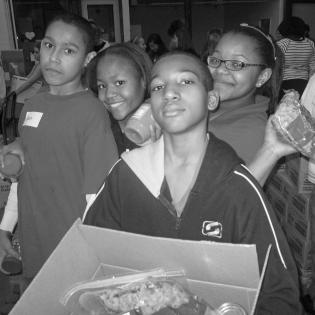Bowls of Love
Based on the recommendations of the soup kitchen guest from lesson one, young people decide how they will take action to help address a need. They may donate canned food, volunteer to serve lunch, bring games to play with children at the soup kitchen, or make bowls to sell as a fundraiser. This lesson describes the bowl fundraiser.
The learner will:
- work cooperatively to plan and carry out the service project.
- clay for each young person about the size of an adult fist
- clay making tools and access to a way to bake or fire the bowls
Families are invited to the fundraiser and they may purchase youth-made artwork. All profits are donated to the local soup kitchen.
- Anasazi Pottery www.clayhound.us/sites/anasazi.htm
- Detroit Institute of Arts www.DIA.org
- Making Hand-Built Coiled Pots www.nativetech.org/pottery/making.htm
Instructions
Anticipatory Set:
Show some examples of pottery bowls, either actual pieces or images from the Internet (see Bibliography). Talk about the colors, textures, and designs of the different pieces. Discuss the purpose of a bowl and how it relates to the soup kitchen. Tell the young people they are going to support the soup kitchen or food pantry they learned about in lesson one. They may choose to volunteer, donate food, or make bowls to sell and raise money for the nonprofit. The decision should be based on their interests and also the needs identified by the nonprofit. This lesson describes the clay bowl fundraiser.
Demonstrate how to use the clay tools and techniques to make a bowl. Make sure they roll up sleeves and remove jewelry (place in pockets) because their hands will become dirty. Clay is easily cleaned with soap and water.
Give each person a ball of clay the size of your fist.
Using a rolling pin, they roll out the clay about 1/4" thick. This can be used for the base and sides of a slab pot. A coil pot starts with any shape slab base and 1/4" wide coils. A round-sided pot starts with a round base and a long rectangle for the sides.
To join two pieces of clay together:
a. score (scratch) the areas on the claly to be joined so they will stick together.
b. attach the pieces with some "slip" (very wet clay).
c. squeeze the two pieces together.
d. smooth the edges.
If using air-dry clay, wait until the containers are dry to paint. Tempra or water colors work well.
If using oven baked clay, bake according to directions until done. When cooled, paint with tempra or water colors.
If using a kiln, stuff the bowl with newspaper to support the walls while firing. The newspaper will burn off. Select your glazes, paint, and fire again.
Discuss the best way to have a fundraiser. Probably the best option is to have an open house with snacks. Guests can be invited to view all the pieces and then purchase them on a first-come, first-serve basis. Other options include making a catalog, holding an auction, and displaying from a booth at a larger festival.
Discuss when and where the fundraiser should be located and who should be invited. Make advertisements or invitations and include the time, place and purpose of the event.
Discuss how much money you would like to raise for the soup kitchen and discuss how prices will be determined.
Each young person writes a description of their piece. The writeup should include a name for the piece as well as a description of its purpose, materials, process used, and a description of the colors or design. The final piece should be printed on a card or in a sales catalog.
Work together to plan the fundraising event. Plan snacks and share responsibilities for carrying out the event.
Any money raised should be presented to the soup kitchen director.
After the event, reflect in writing about the success of the fundraiser.
Philanthropy Framework
-
Strand PHIL.IV Volunteering and Service
-
Standard VS 01. Needs Assessment
-
Benchmark E.1 Identify a need in the school, local community, state, nation, or world.
-
-
Standard VS 03. Providing Service
-
Benchmark E.2 Describe the goals of the project and their impact.
-
Benchmark E.3 Describe the task and the student role.
-
-
Standard VS 04. Raising Private Resources
-
Benchmark E.3 Describe a service plan.
-
Benchmark E.4 Set a fund-raising goal and identify sources of private funds.
-
-
Standard VS 05. Integrating the Service Experience into Learning
-
Benchmark E.2 Evaluate progress on the service-learning project before, during, and after the project.
-
-
